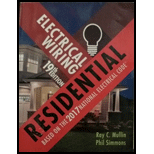
Concept explainers
Find whether the outlets in a circuit can be arranged in different groupings to obtain the same result.
Answer to Problem 1R
Yes, the outlets in a circuit can be arranged in different groupings to obtain the same result.
Explanation of Solution
Discussion:
The general purpose receptacles and the lighting outlets can be supplied with more than one circuit. If any problem occurs in one circuit, other circuit can manage the power supply to the outlets in the specified room.
Another way is to use the general purpose receptacles on one circuit and the lighting outlets on another branch circuit. Branch circuit runs first to the switch and then to the controlled lighting outlets. This running process is maintained and followed in order to keep the outlet box at the lighting outlets or the wiring compartment on recessed cans less crowded. The switch location includes grounded circuit conductor using which the switching devices are easily installed whenever the switch requires the connection of grounded circuit conductor.
Conclusion:
Thus, the outlets in a circuit can be arranged in different groupings to obtain the same result.
Want to see more full solutions like this?
Chapter 8 Solutions
ELECTRICAL WIRING:RESIDENT.-TEXT (PB)
- In Experiment PD controller How would the equation become if it were Kp=1 KD=0/0.1/0.5/1/10 s+1 0.02s+1arrow_forwardDon't use ai to answer I will report you answerarrow_forward4. Discussion: GINEE Compare between theoretical combination effect of Kp and KD at first order and second order systems regarding steady-state errors and transient responses with the practical obtained results whenever applying step input signalın Experiment PD controller و المهندسة الكهربائيةarrow_forward
- b C Is 3601116-67 Bre ✓ BIb ≤5K 20k e 0-25K 7. Zo Z Zb B=100, Ble=1Kr Zb=S & Zin = S, Zo=S, AV=Sarrow_forwardDon't use ai to answer I will report you answerarrow_forward4. Discussion: GINEE Compare between theoretical combination effect of Kp and KD at first order and second order systems regarding steady-state errors and transient responses with the practical obtained results whenever applying step input signalın Experiment PI controller و الهندسة الكهربائيةarrow_forward
 EBK ELECTRICAL WIRING RESIDENTIALElectrical EngineeringISBN:9781337516549Author:SimmonsPublisher:CENGAGE LEARNING - CONSIGNMENT
EBK ELECTRICAL WIRING RESIDENTIALElectrical EngineeringISBN:9781337516549Author:SimmonsPublisher:CENGAGE LEARNING - CONSIGNMENT
